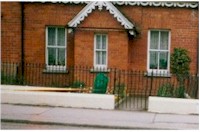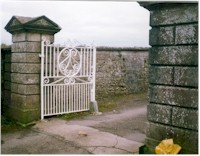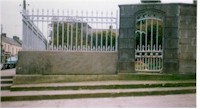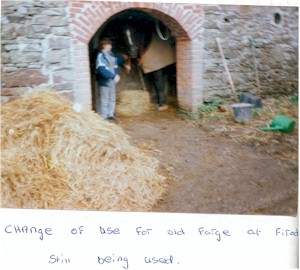

Railings at Florence Terrace made by McCarthy's
Gate at Parochial house
made by McCarthy's
Re-searching forges in the 'comer area proved to be an interesting and amusing exercise. Interesting in that it throw up a wealth of knowledge and showed that there were as many smiths in days gone by as there are publicans today. Ironically many of the smiths had their forges in publicans yards- the advantage of which are fairly obvious. Amusing in that memories have faded over the years and accounts not to mention dates were often conflicting. The high esteem in which the smithy was held was very apparent from listening to the way old people spoke of his skills.
From the information we received we compiled the following report which we believe to be reasonably accurate while not being solid enough for the history books
There were basically four types of smiths in the area over the years
[a] Smith- Farrier- Wheelwright- "complete set up."
[b] Smith- farrier
[c] General smith only
[d] Farrier only
(A) The Smith- Farrier- Wheelwright had a complete set up. The business consisted of the smith who shod horses, made and manufactured farm and kitchen implements and in general did any work that involved iron. His partner, the wheelwright made wheels, carts, bogeys, and any other timber accessories needed to complete an implement made by the smith.
(B) The Smith -Farrier was basically a farrier but also involved himself in small iron jobs and repairs.
(C) The General Smith did not involve himself with horses or timber. He just did iron work and repairs ie. Ploughs, kitchen utensils, etc. His work had often to be brought to a carpenter for finishing
(D) The Farrier only, did as suggested. He shod horses and donkeys only. He was not involved in iron work or carpentry. He was usually skilled in horse care and in his own right was a kind of untrained vet. The farrier was never short of work as there were always more horses and donkeys in the area then than there are cars today. Some farriers were in full- time business but many other-especially during war years were farmers who had acquired the skill and had just shod their own horses and their neighbours horses.
As mentioned already the arrival of the car and tractor together with other modern methods sounded the death of the smith. The only survivor was the farrier who if lucky enough got employment at a race horses stables.
Such was the case in Castlecomer where from a selection of over a dozen smiths only one survives to the present day
-At the Square Castlecomer are the only surviving smiths in the
area. Their work now consists of farrier work. The father and sons move around to
the farms and the stables in the county shoeing horses. The business
was
started over a 180 years ago in Coon
by Mr Comerford's grandfather. It ceased for a while in the 1900’s but was
started again in Castlecomer around 1960 by Mr. Comerford. At this time the
business was generally smith and farrier –no carpentry. Shoeing horses, making
gates, fires, grates etc. was the
work. One existing piece of work from that forge is the iron ladder up the water
tower at Firoda N.S.
Located at
Conways yard -now known as the "Stables" public houses, was the best known forge in
the area. The Phelans were also the last native smiths in the locality. Their
tradition goes back a long way.
Mr.
Martin
Phelan started about a 100 years ago at Slatterys forge in Pearses' yard- now
belonging to Mr. Brian Harrington Vet. He then emigrated for a while and
when he returned, took up work at Mr. Dan Carrolls forge at Barrack street, opposite
Bollards pub - then Kennys. Mr Phelan then worked for a while at Fogartys forge,
Chatsworth street where his cousin Mickey was already working. He then moved to
Conways yard where he set up his own business around the 1930’s
Paddy, his nephew, together with his
father Jimmy, a skilled wheel wright cum carpenter took over the business and
held it until it closed in 1972. Paddy worked for seven years at nearby Mc
Carthys forge. At Conways yard Jimmy and Paddy Phelan ran a very efficient
business. Paddy did the smith work and farrier work while Jimmy made horse carts
and bogeys, handles for sprongs and many other works.
Paddy told us that the skill of a smith
lay in his ability to recognise the different heats-“hates” as he called it
('comer accent). This was done by watching the colour of the iron and one of the
most difficult tasks was to “heat weld” two pieces if iron together. This
was done by getting the pieces to a great “weld heat” and striking them
together until they became one
This forge at Kilkenny St. -beside Conways was a general smith only. It finished as a forge in the early 60’s when Dan Mcarthy worked it as a car garage. His skills as a smith were useful in the garage business. It was Dan,s father Joe who ran the business as a general smith. He concentrated on gate working and making railway’s etc and never touched on farriering. That dates back to 1868 and we believe that “Joes” father was also in the business. A fine example of Mc Carthys work is the entrance gate to the Parochial house and also the railings in front of “ Florence Terrace” at Kilkenny St.
|
|
|
|
Railings at Florence Terrace made by McCarthy's |
Gate at Parochial house |
Dan Carroll had a forge at Barrack St. where he mostly did farrier work and a little general smith work. His brother “John” had a similar set up just up the hill at the foot of barrack hill -then known as gallows hill. These operations closed in the 50’s
|
|
 |
|
Iron work at Castlecomer Cemetry |
Creamery Railings at Castlecomer |
At Chatsworth St. was a complete set- up. Michael Fogarty who died in 1907 was the smith. He also ran an undertaker business -a hearse drawn by two horses and a taxi service- it was known as Fogarty’s brake. The building is still standing and the mill race which ran across the top of the yard was a very handy supply of water for cooling the metal, watering the horses and cleaning the hearse and “brake”. Prices at one stage for shoeing a mare were 1 shilling and 6 pence (about 8 current pennies)
|
|
|
|
The Forge -still standing |
An old bill |
Martin and Mickey Phelan Worked in this forge at one time in
their career. When Michael died, his widow Honoria and son Frank ran the
business. Frank then branched into mechanics and switched the business to a
garage. He moved the premises across the street to where Rowe's hardware is now
located. He operated as a mechanic and as an radio engineer until the early
50’s when the garage was sold to Mr. Michael Healy who in turn sold it to the
Deleaney brothers. In the early 70’s it changed hands again and the old
building was replaced with the existing hardware store. Frank Fogarty was
reported to have the first motor car in Castlecomer. A feature at the old forge
was the existence of cobble stone on the yard, up to a few years ago.
Down the street where Richard Fogarty ran an undertakers was another forge. This was for use in the coach
building business that was carried on there.
CANTWELLS
at
Rowes yard and BYRNE'S ,at Coogans yard, the square were farrier only operations which
ended in the 50’s.
SLATTERY'S
at Pierce's yard was a general smith and farrier which was in operation in 1888
but we could not find out when it started or finished.
BRANNIGANS
of lowhill and JACK
BRENNANS of Firoda were examples of farrier farmers who just shod their own
horses and those of their neighbours. During the war especially, when iron and
money were scarce this kind of farrier was very common in the area.
|
|
 |
|
Forge Site at Lowhill |
Forge at Firoda converted to Stable |
|
|
|
|
Forge Site at Crutt |
Meath girl Elizabeth Brogan first woman Farrier |
DEVLINS
of
the Spike Castlecomer are still
operating small time as a farrier who moved around to the farms shoeing the
remaining horses in the area.